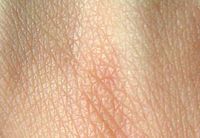
Back Vel Afrikaans Haut ALS ቆዳ Amharic Piel AN Akpalek ANN جلد Arabic ܓܠܕܐ ARC ছাল Assamese Piel AST Ocaki ATJ

Skin is the outside covering of mammals and some other animals. It has many purposes. First of all, it is a defense against the entry of pathogens such as bacteria and parasites. Second, it regulates (keeps in control) the body's temperature. It allows evaporation from its surface, and adjusts it. It is a physical defense, very strong in some animals, but rather weak in humans. The skin and hair on mammals has several purposes. In addition to temperature regulation and defense, some hair is used for signaling.
Most animals add other defenses to their skin. Mammals have hair or fur on their skin. Birds have feathers on their skin. Most fish, and reptiles, like snakes and lizards, have scales on their skin.[1]
Humans can have different skin colours like black people and white people depending on their race and has to do with genetics.
The skin is actually the largest organ of the human body. Without skin, humans would easily get infected with diseases. Skin helps regulate body temperature. Skin lowers the potentially harmful effects of UV rays. As part of the immune system, skin can help warn people to certain diseases.[2]
Clean skin is important to health, and all mammals groom their hair and skin. Skin care is much work.
Skins can be made into leather. Leather is sometimes used to make shoes, bags, and balls.
- ↑ "Skin: Layers, Structure and Function". Cleveland Clinic. Retrieved 2021-11-11.
- ↑ Team, Gundry MD (2021-11-04). "What is healthy skin and how do you achieve it?". Gundry MD. Retrieved 2021-11-11.